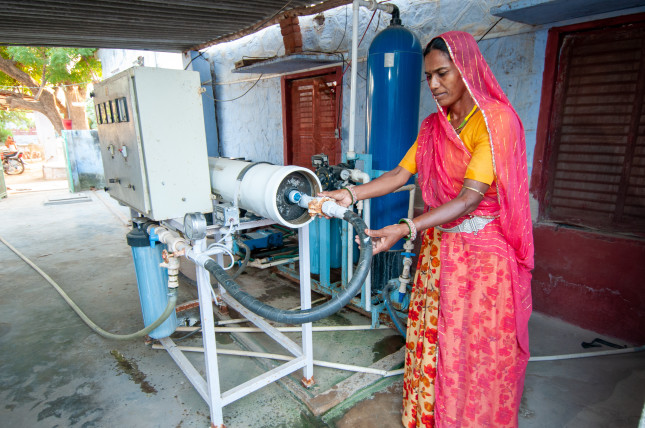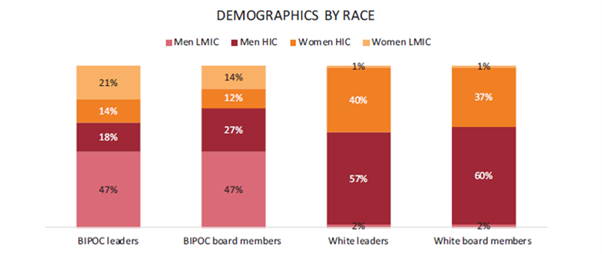-
Achieving SDG 6.2: Adequate and Equitable Sanitation and Hygiene for Who?
October 8, 2021 By Georgia HalesInternational development organizations do not exist outside of global systems of oppression. However virtuous their intentions, the power held by development actors remains largely in the hands of the western elite, echoing colonial-era global dynamics.
Our recently published study found that the leadership at influential organizations focused on sanitation—an integral part of international development and global health agendas—is dominated by older, white men from high-income countries (HICs). This raises questions about the hiring and promotional practices in the sanitation workforce that prevent certain groups—namely females of color from low- or middle-income countries (LMIC)—from entering leadership positions. We cannot separate this finding from evaluations of the sector’s effectiveness. How well can a white man from a HIC understand a woman’s deeply personal and cultural sanitation needs from an LMIC?
Our analysis—the first quantitative study of leadership demographics within the sanitation sector, representing 1,472 individuals within 105 global sanitation organizations—provides a baseline to understand the many policy failures and resource waste in the sanitation sector. One thing that’s clear—increasing leadership diversity at the regional, national and global levels is key to achieving SDG 6.2, access to adequate and equitable sanitation and hygiene for all.

A lack of DEI is hampering efforts to meet SDG 6.2
Diversity, equity, and inclusion (DEI) in leadership is one lens we can use to examine how heavily white supremacy, patriarchy, heteronormativity, ableism, and other societal structures influence development work. Evidence shows that a workforce with good DEI improves the impact of global health programs.
The largest demographic represented in our study was white men from HICs, who held over a third of all leadership positions. Over two-thirds of leadership positions were held by white people. White people were also 8.7 times more likely that people of color to be in leadership positions in more than one sanitation organization (i.e., a board member for one organization, and CEO for another. This creates an even larger platform for white voices, underlining the clear systemic preference for whiteness in positions of power.
Men accounted for 60 percent of all leadership positions. Gaps in representation between males and females of color were larger than those between white males and females, highlighting that women of color experience multiple systems of oppression and face greater barriers to positions of power.
What was also apparent was the disparities in the ages of the leaders. The majority of white male leaders were over the age of 55. This age difference suggests that white men rose to power in decades when the sector was more engineering-oriented (typically a male-dominated field) and never left. The maintenance of power with an older generation of leaders is not a problem confined to sanitation. Many sectors recognize the career progression challenges young staff face when there is no space at the top. Additionally, research has shown that this creates a problem for diverse hiring as, consciously or not, individuals will often hire candidates who appear culturally similar to them.
Headquarter location strongly influences an organization’s internal structure and transnational operational dynamics. For example, Oxfam recently relocated its headquarters to Nairobi as part of a “concerted effort to devolve power and capacity away from the North to the South.” Our study found that 88 percent of sampled sanitation organizations had their headquarters based in a HIC. Only 17 organizations had their headquarters based in the country of their programmatic focus. The majority (56 organizations) were headquartered in a country where they did not have operations, further demonstrating the structural reality that power, finances, and decisions are concentrated in HICs.
The educational institutions attended by sanitation leaders provide insight into the various pathways and funnels to power positions. The most prevalent universities were Harvard University, Oxford, and Georgetown University, highlighting the preference for degrees obtained from HICs. Not only does this indicate that individuals must have certain means to obtain a certain level of power, but it also highlights the places in which sanitation knowledge is created and disseminated. This plays a major role in what post- and de-colonial studies have termed epistemic hegemony.
What to do?
The results demonstrate the unacceptable, neo-colonial reality that organizations must actively challenge and reject. While our research lists about ten evidence-based recommendations to improve DEI leadership from the development, health, and business sectors, we have selected a few highlights below for practical policy and programmatic action
First, each professional in the development sector needs to acknowledge that structural systems of oppression exist and pledge to use their privilege and power to dismantle them. That is a critical step to moving to the other recommendations in a meaningful way. Become a vocal advocate for marginalized groups, highlight clear paths to leadership, and invest money resources into training those staff. This includes advocating for more diverse voices to be included in roundtables and high-level panel conversations.
Implementing organizations have a lot of work to do to create cultures of belonging and inclusiveness for all. First, they need to develop their definitions of DEI by aligning core values and strategic plans by creating specific input- and output-related goals and key performance indicators. This should include enacting internal policies that promote diverse leadership and inclusive workplace cultures, such as inclusive job descriptions, recruitment accountability mechanisms, and performance management systems. When it comes to retaining diverse staff, organizations should also remove barriers to career progression through equal, paid parental leave, flexible working hours, laundry facilities, and nurseries or after-school clubs for staff children.
To encourage more impactful work in the long-term, the sector can give greater autonomy to organizations within program countries, by taking steps such as the relocation of headquarters, transferring power and resources, and hiring LMIC nationals instead of expats.
Transitioning the sector to center DEI as a strategy will take time, but ultimately, the future of positive social and environmental impact depends on it.
Georgia Hales is an intern at FLUSH and a PhD candidate within the Water-WISER center for doctoral training at the University of Leeds, directed by Professor Barbara Evans. She co-authored this research with Kimberly Worsham from FLUSH, Ruth Sylvester from University of Leeds, Kelsey McWilliams from Point of Shift, and Euphresia Luseka.
Sources: American Journal of Health-System Pharmacy, American Sociological Review, Civil Society News, Environmental Health Insights, Global Fund Community Foundations, Medium, Revista Brasileira de Política Internacional, Social Science & Medicine, UK Government.
Figure Credit: Courtesy of Kimberly Worsham/FLUSH.
Photo Credit: A rural woman while operating water treatment plant, courtesy of PradeepGaurs, Shutterstock.com
 A Publication of the Stimson Center.
A Publication of the Stimson Center.





